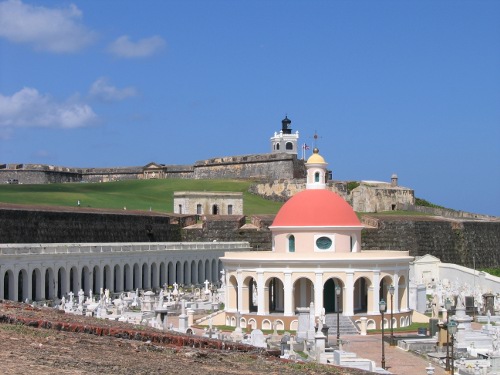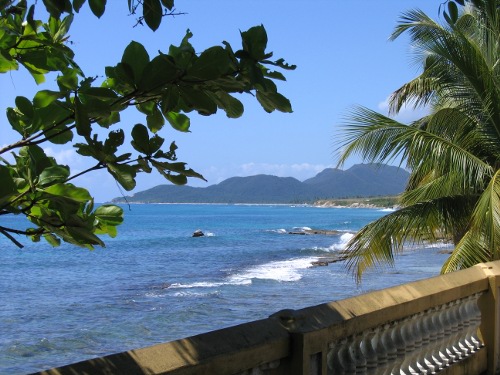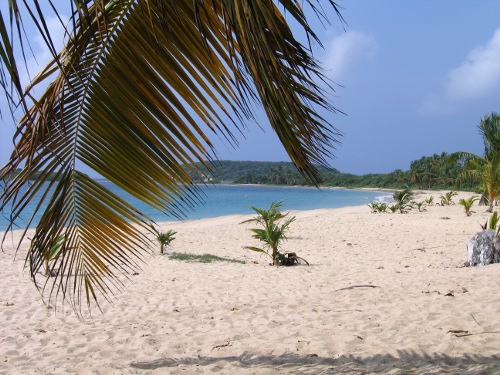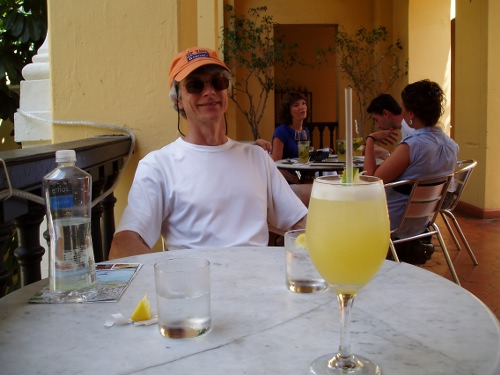Vieques, Puerto Rico, March 2010
The target this year for our winter escape was Vieques, a small island off the coast of Puerto Rico that is relatively undiscovered by the tourism industry. It has the charm of being relatively undeveloped, a rare find in the Caribbean. Much of the island is now a National Wildlife Refuge. It was once the target for Navy bombardment practice, and many of the beaches are still off limits until the Navy can clear them of contamination and ordinance.
We flew into San Juan where we stayed for two nights at the Hilton Double Tree in the Condado region. That gave us the opportunity to explore Old San Juan and its forts. It also gave us the chance to stumble across UmmO, a very good Argentinean restaurant, where we ate and drank entirely too much. We carried a partial bottle of wine home that night to drink the next evening.

The beautiful Cementerío de San Juan with Castillo San Felipe del Morro in the background. The pink-domed chapel is dedicated to Santa Maria Magdalena de Pazzis. The fort, El Morrow, was constructed beginning in 1539 and continued under construction until 1787. It is one of two old Spanish forts in Old San Juan. Over the course of three centuries, El Morrow repelled attacks by the British, Dutch and French.
Our route to Vieques took us to the little local airport in Isla Grande, where we boarded a Cessna 208 for a beautiful flight across to the island. Our host, Mimi, met us at the airport and drove us across the island to our little casita, where we would stay for the week. Mimi and her husband, Joe, were excellent hosts and became good friends. They gave us invaluable insight regarding beaches, snorkeling sites, restaurants and island life. We found ourselves spending very pleasant evenings sitting on their porch having cocktails and visiting.
The casita, a small bungalow built behind their house is known as Jaime's Escondite. We could walk down to the Malecon, the little seawall and walkway along the beach in Esperanza, the smaller of the two towns on Vieques. All the restaurants, bars, small hotels and shops are along the Malecon, which stretches less than half a mile in length. We rented a car from our hosts to go elsewhere on the island. The "Pirate Hooker" or "Beach Buggy" as it is variously called is a rather dilapidated but functional small SUV that has nothing to fear from the elements, rugged dirt roads to the beaches or petty thieves.

The view from the Malecon in Esperanza
Once we were settled into the casita, we drove across the island to the Super Descuento Morales, the only grocery store with off road parking on the island. They had some basics there, including wine and rum, but for produce we had to visit the open market set up behind the produce truck that comes to the island by ferry on Tuesdays and Wednesdays. Driving is an adventure there. Wild horses left over from the days of the Spaniards roam the island and the roads are in many places about one and a half lanes wide. There are no traffic lights on the island. Our greatest laugh on the road came while we followed a car pulling a "trailer" made from a shopping cart. Getting to some of the beaches is definitely off-road traveling at its best.

Sombe (Sun Bay) where we spent one morning reading books and enjoying the view
We snorkeled on some beautiful reefs, some right off the beaches, others accessed by a sailboat we took a ride on one day (Chris and Barb are wonderful hosts on the Marauder). We had nothing but sunshine every day, and in spite of using sunscreen, it got the best of us while snorkeling. We found the key to hiking on the island was getting up early enough to be back to a beach for swimming by the time the heat of the day set in. One morning we got up and hiked out to the end of Caya Tierra, a small wooded atoll connected to the coast by a narrow strip of land between Esperanza and Sombe. From the rocky promontory we had beautiful views across the Caribbean and back towards the two beaches.

Kathy enjoying her hike out to Caya Tierra. The bay and Esperanza are to the left; Sombe (Sun Bay) on the right.
The food in the restaurants was generally quite good, most of it of Mexican or Puerto Rican theme. Kathy made it her project to find the best Margarita on the island, while I attempted to compare all the Puerto Rican rums (Cruzan Single Barrel Estate Rum is pretty hard to beat). There was one fine dining place in Esperanza called El Quenepo, where we made reservations one night and had an incredible meal. Other times we ate a quick meal in our casita.
One of the highlights of the trip was a evening boat ride in the brightest bioluminescent bay in the world. Apparently there are five such bays, two in Australia and three in the Puerto Rican region. The best is on Vieques at Mosquito Bay. We timed it perfectly and arrived on a night of the new moon. Our guide was not only an expert on the bay and the ecology of the island, but also astronomy. The waters glowed anytime they were disturbed, either by fish, the boat or people swimming. We even saw a ray swim by glowing just under the surface--very cool!

Steve looking happy preparing for a lunch at El Picoteo de Tapas in the El Convento Hotel in Old San Juan. The hotel was once a 17th-century Carmelite convent. That's Kathy's margarita in the foreground!
When it came time to leave the island, we once again boarded the little Cessna. Much to Kathy's terror and my amusement, she got seated in the copilot's seat for the trip back to Isla Grande. I rode behind the pilot and took pictures of Kathy's adventure. Kathy swore we weren't going to hit the end of the runway and were doomed to end up in the ocean (the runway starts right at the beach), but we landed safely in Puerto Rico. We spent another night in another hotel (Courtyard by Marriott), this time in the Isla Verde region, where we had a nice room with an ocean view. We traveled back into Old San Juan to complete our explorations there.
The trip home went well, and, best of all, the snow was gone when we arrived!
More pictures and commentary from our trip